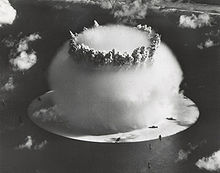This article needs additional citations for verification. (August 2020) |


A transient condensation cloud, also called a Wilson cloud, is observable surrounding large explosions in humid air.
When a nuclear weapon or high explosive is detonated in sufficiently humid air, the "negative phase" of the shock wave causes a rarefaction of the air surrounding the explosion but not of the air contained within it. The rarefied air is temporarily cooled, which causes condensation of some of the water vapor within the rarefied air. When the pressure and temperature return to normal, the Wilson cloud dissipates.[1]
- ^ Glasstone, Samuel and Philip J. Dolan. The Effects of Nuclear Weapons, U.S. Dept. Of Defense/ Dept. Of Energy; 3rd Edition (1977), p. 631